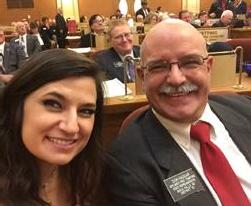
26 minute read
States Work Together to Reunite Families
by Daniel Logsdon
Parents play the most essential role in a child’s life, but when families struggle or break down, states often become responsible for providing a safe and secure home base. There has been a shift in focus, however, to help families overcome challenges so that more parents and children can be reunited.
According to Tennessee state Rep. Raumesh Akbari, there is a real commitment in her state to stabilize children in need, but there is also an effort to stabilize the parents so the family can ultimately be reunited. While state foster care agencies will always focus first on protecting children, providing assistance for families has shown positive outcomes. There has been an increased focus on providing new techniques to strengthen parents and foster parents. Many states are now implementing projects that help provide training and capacitybuilding programs for families. Nevada is one of a handful of states using a new tool called the Quality Parenting Initiative, or QPI. Developed by the Youth Law Center, QPI is an approach to strengthening foster care and enhancing a foster parent’s ability to meet the tremendous challenge of caring for kids. Reesha Powell, deputy administrator of child welfare with the Nevada Department of Health and Human Services, said QPI empowers child welfare agencies to better partner with foster parents, but also partners foster families with the child’s family to assist with the reunification process or long-term solutions for the kids. QPI achieves this by creating relationships between agencies and foster parents to help build capacity and ultimately better care for the kids. “It’s really about putting a team around that child to get them to reach permanency more timely,” Powell said. According to Powell, QPI represents a significant change from past practice. “When I first came into this practice, there was this belief that children were better served if they were in foster care and removed from their family … and I think nowadays we do a much better job of trying to keep children in their birth home or in their family home and try to work with the family to mitigate whatever circumstances exist within that family that are causing neglect or abuse to occur. So it’s a paradigm shift for us,” Powell said. However, Powell said the paramount concern is for the welfare of the children. “Obviously if there is an immediate risk of danger to a child or what is called ‘present danger’ to a child, we have the ability to immediately remove them
from the situation and place them in alternative placement whether it be with a relative or a foster care provider. That is typically how kids come into care … if we have been working with a family trying to mitigate the circumstances within the home and it appears that it’s not working, we can remove the child at that point.” “The bottom line is that foster care is supposed to be a temporary help. What we want to make sure is that the child—who has probably encountered some sort of trauma in being removed from the home—is in the best possible position,” Akbari said. “It is important to make sure that child feels loved, that they have ade quate mental health counseling and family support, that there is an ultimate goal to get them back into their house and, of course, that they have the same educational opportunities so that they don’t have this transient lifestyle where they are constantly moving and not being able to have a foothold in the educational system.” State court systems are also stepping up to help children, especially those who are victims of the opioid epidemic. “Everything we know about opioid addiction tells us that an addicted parent will be unlikely to move from addiction to safe parenting, or achieve sobriety, within the timeframes set for children to have a proper nurturing home.” Ohio Chief Justice Maureen O’Connor said. “Recovering in time to meet the normal permanency timeframes is extremely difficult for parents with opiate addictions. Why? Because the paths to recovery can be long and often there’s a scarcity of resources to support addicts. Permanency planning must be based on the best interests of the child, and the child’s needs and the parent’s recovery paths usually don’t line up when it comes to opioids.” The Ohio court system is working to tackle this issue with Family Dependency Treatment Courts, or FDTCs, O’Connor said.
“Currently, 30 of Ohio’s 88 juvenile courts have an FDTC that’s certified by the Supreme Court of Ohio,” she said. “The number of FDTCs has grown in the last few years, yet we need to recruit more counties to launch FDTCs. National research findings have demonstrated better results for families when substance-abusing mothers participate in a family drug court.” According to O’Connor, early identification of cases involving substance use disorder, immediate access to treatment services and support and more judicial oversight to ensure accountability of all parties can lead to better outcomes for families.
Nationally, the Interstate Compact for the Placement of Children, or ICPC, is working to catch up with the states. The Association of Administrators of the Interstate Compact on the Placement of Children, or AAICPC, is working to pass a new interstate compact that will address the deficiencies of the current compact, which was established in 1960.
As the AAICPC notes in a policy brief issued in 2013, “While the 20th century welcomed the current ICPC as a novel and useful process for negotiating interstate placements and sustaining care and well-being of children placed beyond a state’s borders and its jurisdictional authority … the current ICPC at best, provides for a fragmented system that breeds an inefficient and sometimes ineffective use of time and resources on the part of state and county governments, the courts, and stakeholders … .” Particularly important is the new ICPC’s approach to the interstate placement of children. The bottom line is that foster care is supposed to be a temporary help. What we want to make sure is that the child—who has probably encountered some sort of trauma in being removed from the home—is in the best possible position.”
» Tennessee state Rep. Raumesh Akbari
The current compact causes delays in interstate placements that leave children in foster care awaiting interstate processing and placement six months to one year or more. The traumatic impact of state intervention on children can be lessened if the child can be placed with relatives quickly. However, a state’s ability to bring about these cross-border, emergency placements are difficult given the lack of interstate cooperation, even when willing relatives are available. Addressing this issue is one of the goals of the Regional Judicial Opioid Initiative, or RJOI. RJOI comprises of state court leaders in Illinois, Indiana, Kentucky, Michigan, North Carolina and Tennessee and is the result of the Regional Judicial Opioid Summit held in 2016. Officials in RJOI states are noticing a significant increase in cases where expedited, cross-border emergency placement would help already traumatized kids. While several counties situated on state borders have developed agreements to expedite these types of placement with family members, these agreements, while helpful, are inadequate to address the scope of the problem. Emergency placement and foster care is a difficult issue to tackle, but states are adapting. Through best practices and establishing partnerships with outside agencies and leaders, states are demonstrating that by continuing to work together and focusing on supporting families, outcomes can continue to improve. “Our children are our future, I can’t stress this enough,” Akbari said. “I think that if we can get them in a place where they can be whole in spite of what they’ve experienced then we are going to produce better results and that is the ultimate goal.”
SAFEGUARDING STUDENT DATA

by Courtney Daniel
While technology has opened new doors for teachers, the use of innovative technology in the classroom has resulted in the collection of sensitive student data. Many state lawmakers are now acting to secure vulnerable student information, while also allowing for the educational edge technology provides. According to the Data Quality Campaign, 110 student data privacy bills were introduced in 2014, 180 student privacy bills were introduced in 2015, and 112 student data privacy bills were introduced in 2016—all at the state level.
“Technology is an important component in today’s classroom,” Kentucky state Rep. Steve Riggs said. “But it’s imperative that policies and procedures are in place to protect students vulnerable to data breaches.”
Kentucky House Bill 232, sponsored by Riggs in 2014, requires consumer notification when a data breach reveals personally identifiable information and prohibits cloud computing service providers contracting with educational institutions from processing student data for advertising purposes, or selling, disclosing or processing student data for any commercial purposes. “The bill originally just focused on cyber liability insurance policies,” Riggs said. “When it came to our attention that some companies were mining student data, an amendment was proposed to further extend the issue of data security to include data collected from students.”
From names and addresses to family income, record keeping has always been a practice for schools. As these records moved from pen and ink to the virtual cloud, data has not only become more useful, but also more vulnerable. The federal government initially took on privacy of student education records with the Family Educational Rights and Privacy Act, or FERPA, in 1974. The law applies to all schools that receive funds under an applicable program of the U.S. Department of Education. FERPA gives parents rights to their children's education records, and these rights transfer to the student when he or she reaches the age of 18. According to the U.S. Department of Education’s website, schools must obtain written permission from the parent or student in order to release information from a student's record. However, schools may disclose information such as a student's name, address, telephone number, date and place of birth, honors and awards, and dates of attendance without prior consent.
This information is available to school officials and other similar groups, but revisions to FERPA in 2008 allow educational institutions to disclose information and personally identifiable information without prior consent to contractors, volunteers, or other nonemployees performing services for the educational institution if the request is based on legitimate educational interest. This is what has led many states to enact further protections for student data. In 2016, Arizona passed House Bill 2088, dubbed the “informed consent act,” that requires schools to gain written parental consent before administering surveys that gather information about students such as gun ownership, political affiliations, religious practices, etc. It also restricts non-test data from being included in a state’s longitudinal data system. HB 2088 bill sponsor, Arizona state Rep. Mark Finchem, said he introduced the bill because parents were concerned about the growing number of surveys being administered in schools without parental review or consent. Finchem, who compared the data collection world to the “wild west,” said parents need to be the first line of defense for children.
“Many parents had had enough of the intrusion into their lives and were not comfortable with the amount of information being collected,” Finchem said. “Parents were asking, ‘Where does this stop?’” According to Finchem, claims that student data collection help improve education are not enough to justify the practices that were in place. “Education was never meant to be a factory,” Finchem said. “The real mission is to provide a quality education.” While some lawmakers and parents are fearful sensitive student data will be used by companies for profit, or be compromised by hackers, there is research that shows data collection— when done responsibly—has benefits in the form of educational and economic outcomes. In fact, a 2013 summary of research from the Appalachia Regional Comprehensive Center on the role of technology in student learning found that while no single research study can address the general question of whether technology improves student outcomes, there is evidence that technology can boost student knowledge and skills. The summary referenced a report from Johns Hopkins University Center for Research and Reform in Education that analyzed 84 studies to compare the impact of various technologies on K-12 reading achievement and found that computer-assisted instruction, along with other activities in a reading program produced the largest improvements in reading scores. In addition, a 2013 report from the McKinsey Global Institute showed the exchange of educational data could add as much as $1.2 trillion to the economy through more efficient, effective instruction.
One example of how technology in education is producing outcomes is AT&T’s Aspire program. It has invested $400 million since 2008 to support student success through developing educational applications and curriculum, creating online educational pathways to industry-relevant skills and providing young people across the country with mentoring by AT&T employees. “Education has always been an important part of what we want to invest in. Because we want a great workforce coming along, we want to continue being an innovative company and you can’t do that without having young people prepared with the skills to go in and do it,” said Nicole Anderson, president of the AT&T Foundation. “That is why we invest in education and one of the best ways you can invest in education is through technology.” AT&T expanded this program to the Aspire Accelerator program that aims to enhance education by supporting and mentoring promising and innovative startups in education technology. The companies from the first two classes of
Technology is an important component in today’s classroom, but it’s imperative that policies and procedures are in place to protect students vulnerable to data breaches.” Student privacy is something we take seriously and that’s why it was important for AT&T to sign the Student Privacy Pledge and to be part of that conversation.”
» Nicole Anderson, president of the
AT&T Foundation
the AT&T Aspire Accelerator have reached more than 4 million students and are exceeding industry growth rates. “Folks in the education space are very comfortable with technology in the classroom. There is a rapid acceptance and adoption in using these tools,” Anderson said. “It’s become more commonplace for people to have these tools. Technology is advancing rapidly and I think the kids are driving this change as well.” And it’s not just state lawmakers who are stepping up to protect kids’ data. AT&T along with companies such as Microsoft, Apple and Blackboard have recently signed on to the Student Privacy Pledge. The pledge, now with 316 signatories, requires school service providers to not collect, maintain, use or share student personal information beyond what’s needed for authorized educational purposes, to not sell student personal information, to maintain a comprehensive security program, and other steps that aim to keep students data secure. “Since AT&T is a tech company, we know that the best way to get to underserved and at-risk populations, and distribute and scale quality education, is to do that through technology and take our core competency and put it forward,” Anderson said. “So, by being interested in that space and putting our philanthropic mic there, we also want to be sure we are safeguarding— and the groups we work with are safeguarding—the information of the students while also helping them improve their academic outcomes in that space. Student privacy is something we take seriously and that’s why it was important for AT&T to sign the Student Privacy Pledge and to be part of that conversation.”

States Turn to Research to Improve Outcomes By Sara Dube and Darcy White for Children and Youth By Sara Dube and Darcy White

Policymakers want to improve outcomes for children and youth but often struggle with how best to allocate limited resources. In recent years, many have turned to evidence-based policymaking—the systematic use of high-quality research in decision-making—to help address this challenge. Extensive analysis, for example, has demonstrated that some interventions achieve outcomes that benefit children and youth—such as reducing child abuse and juvenile recidivism rates. But policymakers need access to these findings to identify, fund and sustain these proven programs. A report released in January by the Pew-MacArthur Results First Initiative assesses the prevalence and level of data-driven policymaking across a spectrum of human services, including child welfare and juvenile justice, in all 50 states and the District of Columbia. The report, which involved an extensive review of over 5,000 state laws and documents, analyzed the degree to which states engage in six evidence-based policymaking practices: defining an “evidence-based program”; inventorying the programs in their state that meet this standard; comparing program costs and benefits; targeting funds to evidence-based programs; reporting outcome data in the budget; and requiring these actions through state laws, codes and rules.
While the report found that the majority of states have used some form of evidence-based policymaking, few have taken the actions necessary to identify the evidence behind their child welfare and juvenile justice programs, assess these programs’ expected returns on investment, and steer funding to those proved to work. By not taking these critical steps, government officials miss the opportunity to focus limited resources on cost-effective programs, identify and reduce funding for ineffective programs, and improve outcomes for children and youth. But, two states—Florida in juvenile justice and Ohio in child welfare—demonstrate how evidence-based policymaking can help lawmakers make better investments in programs targeting children and youth.
How can states better engage in evidence-based policymaking?
To help other states expand their evidence-based policymaking over the long term, the Results First report identified several approaches that states, in addition to Ohio and Florida, have adopted. First, states can increase their commitment to using evidence and data to guide decisions. For instance, New Mexico’s Legislative Finance Committee partnered with Results First to expand its use of evidence to direct resources to the most effective programs. When possible, the committee uses the Results First cost-benefit model to identify interventions that would achieve high returns on investment and uses the results, along with evidence on program
effectiveness, to inform the annual budget recommendations it develops for legislators. The Legislature has used these recommendations to appropriate $161 million to evidence-based programming for adult corrections, behavioral health, child welfare and early education. Second, states can invest in strengthening the infrastructure needed to make their agencies’ data systems compatible and enable staff to conduct analyses that identify cost-effective programming. For example, South Carolina’s Revenue and Fiscal Affairs Office created a centralized administrative data warehouse that includes information from multiple agencies that oversee numerous policy areas, including child welfare and juvenile justice. The central database links data on individuals that are collected by various agencies (such as a juvenile offender whose case information is listed in both a state’s correctional and human services databases) using unique identifiers to protect each individual’s identity. The fiscal affairs office provides guidance on sharing and using this data so researchers can study how to improve outcomes for youth. Finally, states can expand their staff capacity to identify and implement programs shown to be effective. In 2015, the Minnesota Legislature appropriated funds over two years for the state’s Management and Budget Office to hire two full-time employees to inventory programs and analyze returns on investment. Since then, the staff has conducted cost-benefit analyses of corrections and adult mental health programs to inform policymakers on which evidence-based programs would provide the best returns, and the staff is conducting similar analyses on juvenile justice programs. With the growing data on how to build a better future for children and youth, policymakers can expand their engagement in evidence-based policymaking by strategically investing in public programs proved to deliver strong returns on taxpayer dollars.
FLORIDA
With a mandate to divert youth from the juvenile justice system, the Florida Department of Juvenile Justice, or DJJ, has for several years championed an evidence-based policymaking approach to improve outcomes for this population. For instance, in 2011, participation in the Juvenile Justice Improvement Project—an initiative to improve youth outcomes—spurred the department to use the nationally recognized Standardized Program Evaluation Protocol to identify how well the state’s juvenile justice programs adhere to key principles of evidence-based interventions. The department also created a supplementary model that compares programs based on how effective they are in reducing recidivism relative to their oper ating costs. These efforts enabled program providers to identify which programs lower recidivism rates while increasing the return on investment for taxpayers. In 2015, the DJJ expanded its use of datadriven tools when Florida Gov. Rick Scott issued an executive order directing several human service departments to collaborate on improving mental health outcomes for youth. It also—along with the Department of Corrections—partnered with Results First to implement evidence-based budgetary tools to assess the cost-effectiveness of the state’s juvenile treatment programs. As part of the effort to engage stakeholders in evidence-based policymaking, the DJJ hosts Common Definitions, an annual conference for legislative and departmental staff, researchers, and contract service providers to review and offer feedback on analyses of treatment programs and share the latest research findings on improving outcomes for juveniles. Departmental staff members have reported that the conference builds trust, transparency and collaboration.

OHIO
In 2010, the Ohio Children’s Trust Fund—a government entity that is a dedicated funding source for child abuse and neglect prevention programs, led by a 15-member board representing the governor’s office, Legislature, state agencies and the public— turned to evidence-based policymaking to attract private-sector funders and introduce more accountability into how the state’s limited resources are spent. The trust fund used research clearinghouses—databases that provide information on the effectiveness of various interventions—as sources of evidence-based programs it would consider funding. To allow for some flexibility, program providers can implement an intervention that is not listed in a clearinghouse if the intervention meets certain evidence criteria set by the trust fund or the regional prevention councils that administer contracts with child welfare program providers. Providers also must work with program developers on any modifications of a program’s delivery to make sure these changes do not limit the program’s effectiveness. Since shifting funds to evidence-based programming, the number of children entering the child welfare system due to abuse and neglect has declined in Ohio. Kristen Rost, executive director of the trust fund, credits strong leadership, the ability to support decisions with data and a commitment to providing technical support for the state’s success with evidence-based policymaking.
About the Authors Sara Dube directs the Pew-MacArthur Results First Initiative, a joint effort of The Pew Charitable Trusts and the John D. and Catherine T. MacArthur Foundation. Dube manages Pew’s work to advance evidence-based decision-making by states and counties, including the use of an innovative cost-benefit analysis tool that helps government leaders direct investments in programs and policies that generate the best outcomes while making the most of limited resources. In doing so, she brings to state and county partners the latest research on data-driven programs and analytical tools to help assess the true costs and benefits of these taxpayer-funded initiatives. Darcy White is an officer with the Pew-MacArthur Results First Initiative at The Pew Charitable Trusts. In this capacity, White manages research projects to promote evidence-based policymaking in state and county governments. Prior to joining Pew, White worked at the Public International Law and Policy Group, where she conducted research and policy analysis on good governance, and served as a Peace Corps Volunteer in Kenya’s Deaf Education sector. She has a master’s degree from American University’s School of International Service and has published on government performance.



Managing a family as an elected official can be difficult, but when you are serving alongside your parent or child in an elected office, the stakes are even higher. Despite the occasional differences in political affiliations or agendas, these families all agree on two things: the importance of family and teaching young people about the political process.


Rep. Don Haggar represented District 10 of the South Dakota House of Representatives from 2013 to 2017. Rep Jenna Netherton, Haggar’s daughter, represents District 10 for the South Dakota State Senate. She was first elected to the chamber in 2014. “Back in 2014, in a conversation with my 24-year-old daughter, we were lamenting about a lack of representation from our legislators. I told her she should run and if she put the good ol’ fashioned work ethic to use, she would maybe even win! Her victory on Election Day meant she was the youngest female legislator in South Dakota. But that was just the beginning; she recruited me two years later! We ran as a team, celebrated our victories together and pursued legislation that makes South Dakota great. There were times when we would have differences in positions, but good-natured ribbing resolved those differences. It was hard to leave my position as speaker pro tem to join Americans for Prosperity because my time serving in the legislature with my daughter was so gratifying. I’m so proud that she had the courage and the will to step up as a young woman and serve in our legislature.”


Rep. Cynthia Thielen has served the 50th District in the Hawaii State Legislature since 1990 and is the assistant minority floor leader. “I am extremely proud of my daughter, Democrat Sen. Laura Thielen, who ‘outranks me’ in the Hawaii Legislature. I gladly reach across the aisle as a Republican representative to work cooperatively with Laura on issues affecting our districts and state. Recognizing the importance of involving students in government, we host a ‘Legislative Road Show’ in local schools. Students study bills that are currently being heard in legislative committees, prepare supporting or opposing testimony and testify before us, responding to questions, in mock committee hearings. Students particularly enjoy seeing a mother-daughter team with different party affiliations who actually get along, commenting that family dinners must be lively!”


Sen. Laura Thielen, Rep. Cynthia Thielen’s daughter, represents District 25 of the Hawaii Senate. She was first elected in 2013. “Our family spent many dinners talking about current events. We often disagreed, but because we loved and trusted one another we—usually—respected the disagreements and continued the conversation. Our mother was the center of the family, and she showed how to keep people working together despite disagreements. Watching her use that same approach when dealing with other legislators and the public was a great education. She taught me that it’s possible to tackle controversial issues in the short term, while preserving relationships in the long term. So, it’s true when they say that having dinner with your children is critical to raising responsible adults.”
Sen. Bryan Simonaire has been representing District 31 in the Maryland Senate since 2007. “Especially in today’s political environment, it is so important to have the younger generation engage in the political arena. Decisions made today are going to directly impact our younger generation and they need to be part of the conversation.”

Delegate Meagan Simonaire, Sen. Simonaire’s daughter, was first elected to the Maryland House of Delegates in November 2014 and represents District 31-B. “My father is a true public servant, and that gave me a greater understanding of how one person could have a positive impact in a county, state or even country. My father inspired me to enter politics so I could serve the people. He said that young people can make just as big an impact in our community as older people. I took his challenge and now I know he was right: young people can change our world.”

Rep. John Viola is a member of the Delaware State House of
Representatives. He represents the 26th District, and he has been serving the district since 1999. “Engaging youth gives young people a place in the decision-making process, builds a broad base of long-term citizen involvement and creates stronger communities with active community members. I believe it’s the responsibility of the current leaders and policymakers to recognize the benefits that youth offer to our communities, assuring that their fresh perspective matters.”


Rep. Andria Bennett, Rep. Viola’s daughter, has served in the Delaware House of Representatives for the 32nd District since 2012. “Empowering youth to get involved not only in the political process but in civic engagement is crucial in cultivating the next generation of decision makers. We need to let young people know that policymakers value their opinions by giving them useful roles and allowing them to become invested in their own community. They need to know that giving back is crucial in keeping our communities engaged.
From a very young age, I remember my father being involved and giving back. Whether it was serving in the military, being a volunteer firefighter, coaching a little league team, teaching CPR, or leading a civic group, he has always been engaged in the community. It wasn’t until years later that he ran for political office and he continued his desire to give back to his community. I believe growing up with this type of influence has inspired me to do the same. I have been involved in many community service initiatives prior to running for office and continued since being elected.”

Rep. Kim Koppelman represents District 13 of the North Dakota House of Representatives. He was first elected to the chamber in 1994. “I’ve always had an interest in patriotism, public policy and public service and those are the kinds of priorities we hope to pass on to our children, but I never dreamed that I’d serve with one of them in the State Legislature! What a rare opportunity and one which I’ll always treasure. Of course, I appreciate serving with my son, but I also value his unique perspectives and priorities, which makes serving together an even richer experience. His independence, talent and creativity not only make him an effective legislator, but also make one of his colleagues a proud father!”
Rep. Koppelman serves with his son, Rep. Ben Koppelman, who represents District 16 of the North Dakota House of
Representatives. He was first elected to the chamber in 2012. “It has been a privilege to have the opportunity to serve with my father in the legislature. When I was first elected, I think my colleagues had the expectation that I would be just like my dad as a legislator. As time went on, I think they realized that although we share the same core beliefs, my personality, style, interests and areas of expertise are very different. Although we don’t serve on the same committees, it’s always fun when we can be a tag-team on the floor of the House during debate. I definitely value the rare experience of being able to serve with ‘the other Rep. Koppelman.’”


